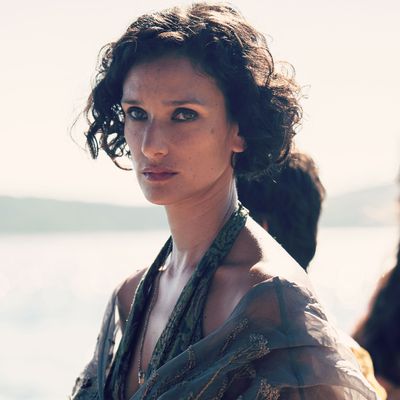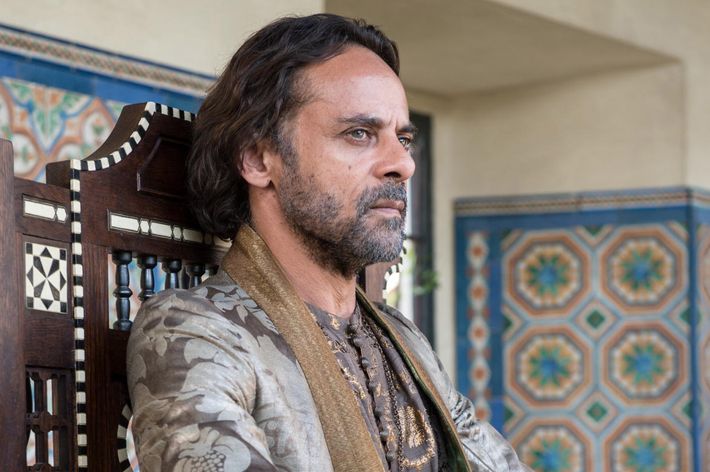
Spoilers ahead for Game of Thrones’ most recent episode.
Dorne! Why are you so terrible? Since we were introduced to the kingdom at the beginning of Game of Thrones’ fifth season, nearly every scene set in Westeros’s southernmost realm has been a dull slog, unencumbered by things like complex characters, exciting action sequences, or meaningful conflict. Sunday night’s premiere saw the brutal murder of half the Dornish plot’s characters, and it was still less interesting than a subsequent scene where a woman took off a necklace. In a fandom where even the smallest controversy can set off a massive internet flame-war, the people are united on this one issue: Please, no more Dorne.
It all started out so promisingly, too. Our first glimpse of Dorne came in the swaggering character of Prince Oberyn Martell, who arrived at King’s Landing in season four with the elegant hauteur of a Real Housewife. As embodied by Pedro Pascal, our Dornishman was as juicy and pulpy as a ripe blood-orange, and he had only one mission: to stir shit up. Oberyn brought his bastard paramour to a royal wedding. He turned Littlefinger’s brothel into his own personal playground. He risked his life in trial by combat, just to troll the Lannister establishment. Sure, the end wasn’t pretty, but the beginning and middle — what a ride!
The rest of the Martells were due to arrive onscreen the next season, and anticipation ran high. Book fans quickly filled everyone in on the background: Dorne was a desert kingdom that had resisted the Targaryens for hundreds of years. It had its own laws that gave women the same inheritance rights as men. Its people ate spicy food, drank delicious wine, and practiced all sorts of freaky sex stuff. How could you mess that up?

But mess it up they did. Book purism is an easy refuge for small-minded Game of Thrones fans, but I think it’s necessary to compare the show’s Dornish plot to the novels’ to see just how this plot line went off the rails.
In A Feast for Crows, much of the Dornish action revolves around the character of Arianne Martell, eldest daughter of the placid Prince Doran. Arianne is ambitious and impulsive; when she suspects her father is scheming to throw her over as heir to Dorne in favor of her younger brother, she seduces the Kingsguard knight who brought Myrcella to Dorne and attempts to crown the young princess Queen of the Seven Kingdoms. This, she hopes, will spark a war, causing the people of Dorne to rally around her. That adventure ends in tragedy, and Arianne is captured and imprisoned — until her father reveals his true plans to her (to make her Queen of the Seven Kingdoms!). It’s a crowd-pleasing moment, but the joy is short-lived: In A Dance With Dragons, we learn that Doran’s conspiracy suffers from its own tragic blind spots, and it too goes down in flames.
Like much of Feast and Dance, this was probably too much to spring on people in the fifth season of a popular TV show. To cut down on the number of new characters, the show scrapped Arianne and focused instead on Ellaria Sand and the Sand Snakes, all of whom are minor characters in the novels. Here’s what they’ve done so far: pled for Doran to take revenge for Oberyn’s death. Gotten mad at him when he doesn’t. Thrown a spear through a guy’s head. Plotted to kill Myrcella as revenge on Cersei. Arrived at the Dornish palace at the same time Jaime Lannister and Bronn arrive to free Myrcella. Gotten in a fight. Been thrown in jail. Apologized to Jaime. Poisoned Bronn, flashed him, then gave him an antidote. Swore loyalty to Doran. Secretly poisoned Myrcella anyway. Stabbed Doran and his bodyguard to death. Jammed a spear through another guy’s head.
Some of that stuff should be exciting! You’ve got sex, violence, betrayal — all the things that people loved about Oberyn. And yet, almost none of it works. Ellaria Sand’s grief has turned her into a two-dimensional villain. Doran’s years of careful scheming have been replaced with … nothing. And the Sand Snakes appear to have no interior lives whatsoever. They’re the TV version of Kate Beaton’s Strong Female Characters, the kind of violent, scantily clad women that emerge when creators want to pay lip service to feminism, but don’t have the time or inclination to create actual three-dimensional female characters.
Throughout it all, there’s been little indication why anyone is doing the things they’re doing. Why does Ellaria want revenge on Cersei, a woman who was only tangentially involved in Oberyn’s death, and had absolutely nothing to do with House Lannister’s earlier atrocities against the Martells? Why do she and the Sand Snakes hate Doran enough to indulge in kinslaying, a supreme taboo in Westeros? And, after staging such a random coup, why do they think anyone else in Dorne would accept them as rulers?
The whole plot line suffers from a lack of context: The only thing that matters is what’s happening onscreen at that exact moment. It’s a problem Game of Thrones has been struggling with in recent seasons. Think back to season one: We had a generally good grasp of King Robert’s court, the various players on the Small Council, the public opinion in King’s Landing. In the seasons devoted to the War of the Five Kings, too, it was easy to get the gist of what each faction wanted and why they wanted it.
But around the time the show got into the material of Feast and Dance, a lot of this context dropped out. Those two books are devoted to exploring the wreckage of the civil war and the chaos that emerges in its wake. The narrative is full of tangents, and the tone is ruminative and regretful — stuff that wouldn’t work on TV, where forward momentum is the way to go. Showrunners David Benioff and D.B. Weiss aren’t the world-builders that George R.R. Martin is, and they understandably used a heavy hand in adapting this material for the screen. Think of Meereen, where the Sons of the Harpy’s major coup was assassinating a crowd of their fellow slave-owners at the fighting pit, and where Tyrion’s rule has consisted of wandering around an empty city. Or take Roose Bolton in Winterfell, who has to periodically remind viewers that he’s about to declare war on the Lannisters, for reasons that still aren’t quite clear. It’s easy to say this stuff is just politics, but at its heart, Game of Thrones is just politics. When it doesn’t make sense, the show doesn’t make sense.
So, where does Dorne go from here? It’s hard to tell — and not just because it’s unclear where exactly everybody is at the end of the episode. (Trystane’s boat was floating off the coast of King’s Landing, which means that Nymeria and Obara are there, too, even though they were on the dock with Ellaria after it left last year.) Are the Sand Snakes about to get into some trouble in the capital? Or were Sunday night’s murders just a way of wrapping up the Dornish misfire for good? If so, it’s hard to imagine many viewers would complain.





